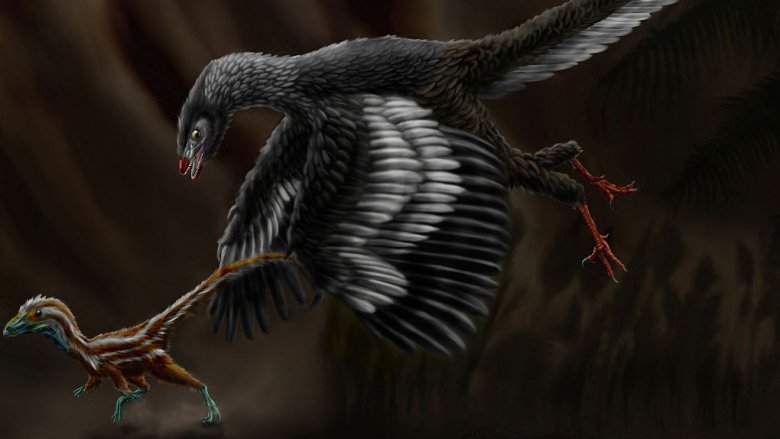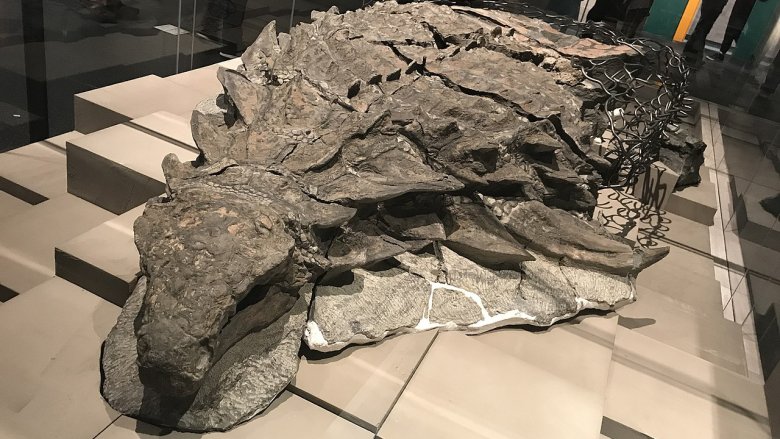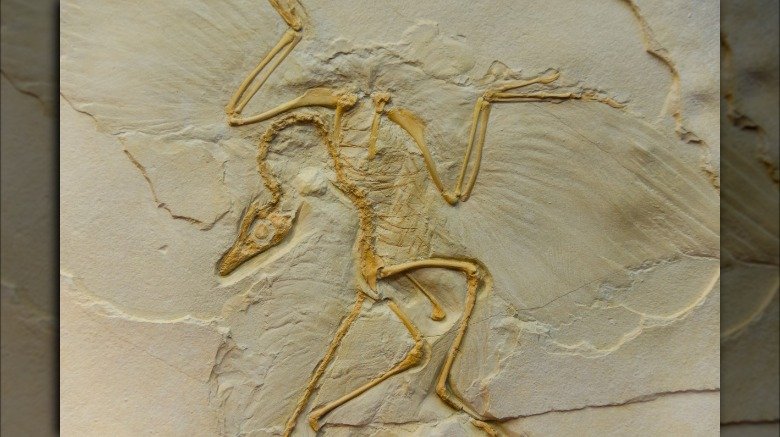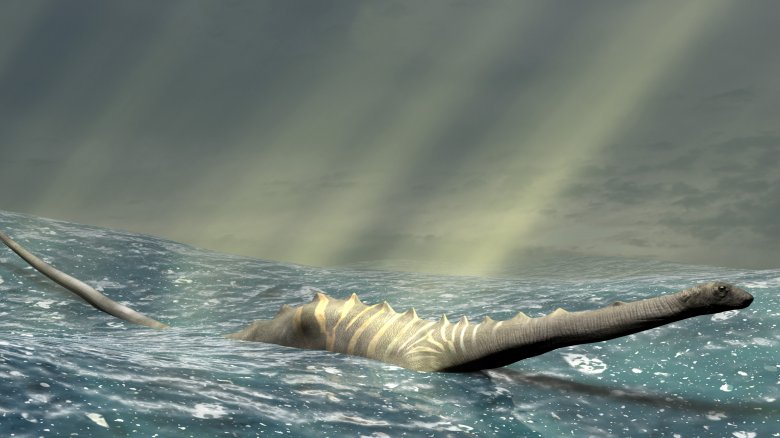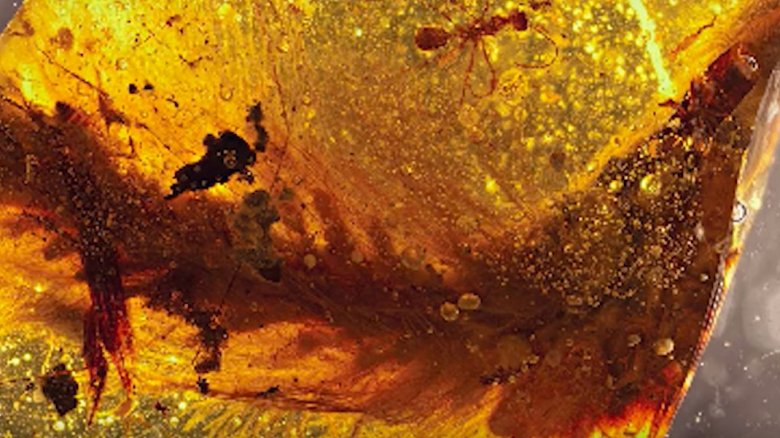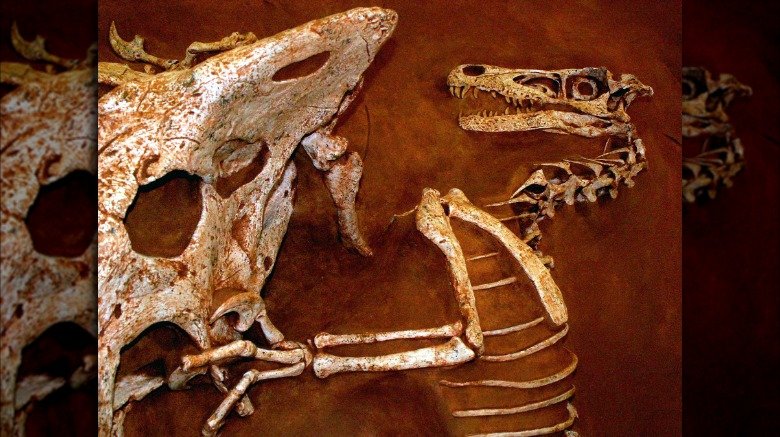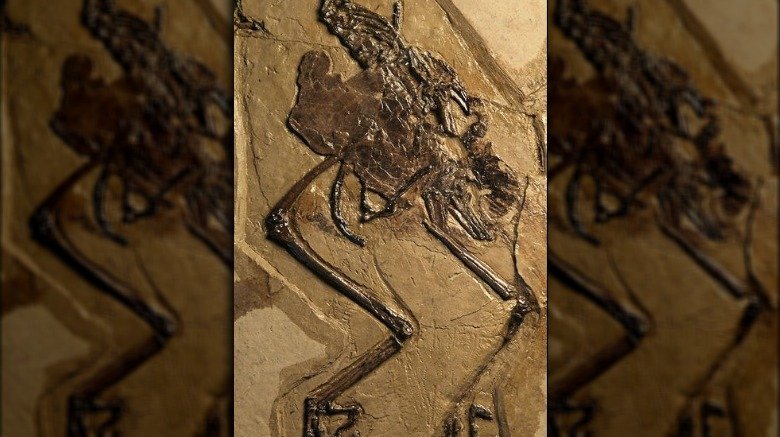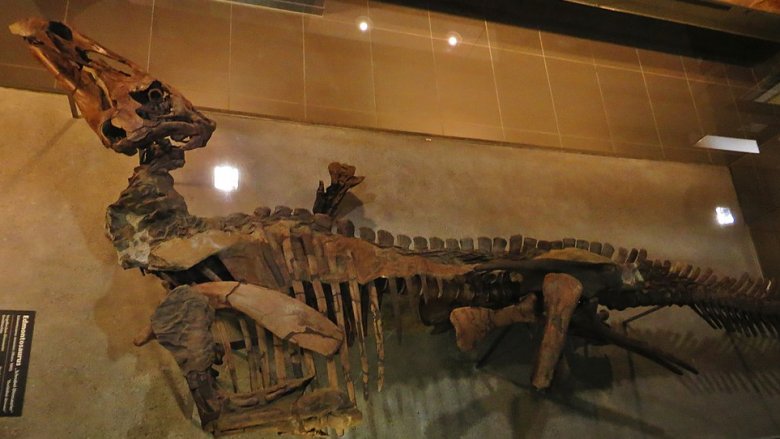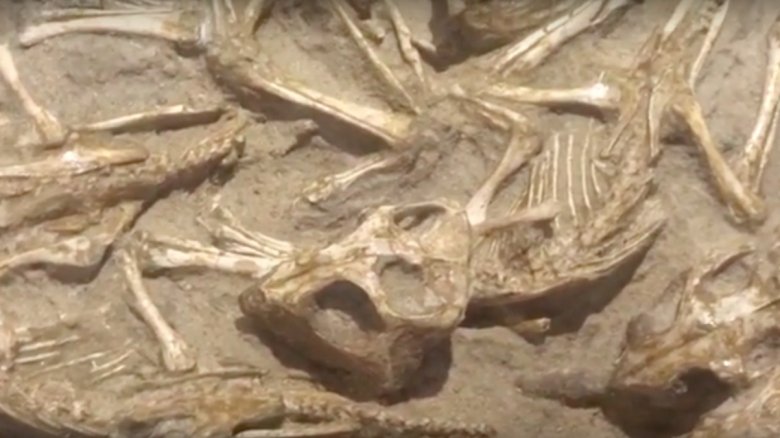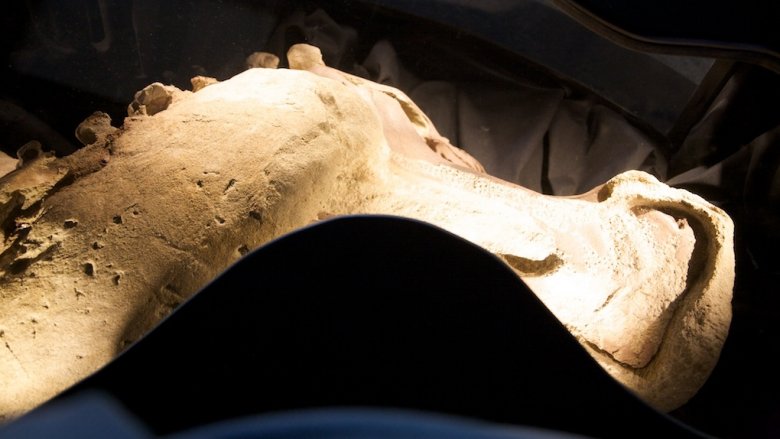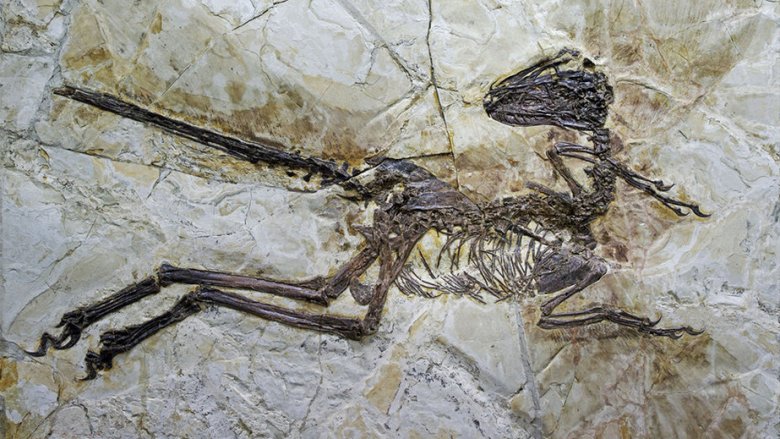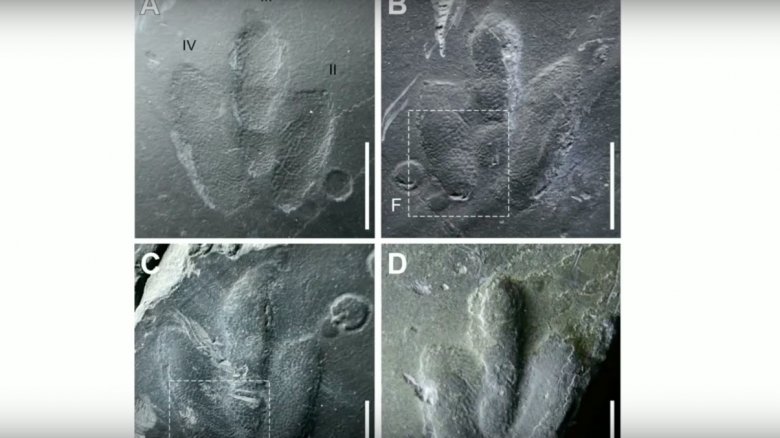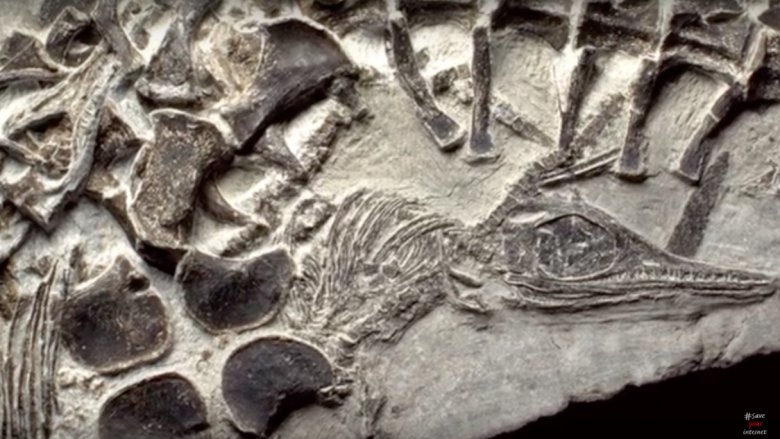Dinosaur Remains That Were Nearly Perfectly Preserved
Robert Plot was the first person in the world to describe a dinosaur bone — that we know of, anyway. It was 1677, and the bone was so baffling that Plot concluded it must have been the femur of a giant. A human giant. But hey, you can't really blame the guy — in 1677 no one had any concept of dinosaurs (although dragons are kind of in the same neighborhood), and once he ruled out elephants, horses, and oxen, what other conclusions were left?
It's also fair to note that Plot had very little to go on. It was just one bone, and moreover it wasn't even a complete bone (we now know it was the lower part of a megalosaurus femur), and since he couldn't exactly consult an encyclopedia of dinosaurs or the Discovery Channel, he had to make his best guess.
Today, paleontologists are sometimes lucky enough to study complete dinosaur skeletons, and sometimes (though rarely) they can study more than just the extinct dinosaur's bones. It's really the exception to the rule, though. Most paleontologists are stuck with bone fragments and partial skeletons. Only the lucky ones got to have a look at some of these scarily well-preserved dinosaur remains.
The dinosaur mummy
The world's oldest natural human mummy is the Spirit Cave Mummy, which dates back roughly 10,400 years. But in geologic terms, 10,400 years is really not that impressive. What would be impressive is a mummy that's, say, a couple of million years old, but everyone knows that's impossible. Flesh and skin eventually disappears, even if it takes thousands of years.
So yes, there is such a thing as a dinosaur mummy, and the most stunning example was actually uncovered pretty recently at the Millennium Mine in Alberta, Canada. The specimen is a nodosaur — an armored herbivore that roamed the earth around 110 million years ago. But the thing that's really unique about this fossil is that it isn't just fossilized bone, it's also fossilized tissue.
A dinosaur "mummy" isn't precisely the same thing as a human mummy. According to Snopes, dinosaurs turn into fossil-mummies when the animal's tissue becomes petrified before it has a chance to decompose. To make a fossil out of skeleton, minerals replace bones and teeth; to make a fossilized mummy, the minerals will also replace soft tissue. That doesn't happen very often, but in this case, the dinosaur's rapid underwater burial allowed minerals to seep in before decomposition was complete. And millions of years later, we get to see what the dinosaur really looked like — in the flesh. The fossilized flesh, but yeah. It's still a pretty amazing thing.
The missing link between birds and dinosaurs
When Archaeopteryx was discovered in Germany in 1860, it was given the nickname "Urvogel" or "original bird." The most famous Archaeopteryx fossil is the Berlin specimen (above), which is the most complete example of the species, and the first one found with an intact skull. The rest of the skeleton is also remarkably well-preserved, but the most impressive thing about the Berlin specimen is the feathers — not only does the fossil clearly show flight and tail feathers, it also shows body plumage and "trouser" feathers covering the legs.
According to the Guardian, the discovery of Archaeopteryx happened just a couple years after the publication of Darwin's On the Origin of Species, so it sort of added fuel to an already raging firestorm of controversy. Some scientists thought it was a hoax and others just flat out denied that the animal's feathers were actually feathers and not some other similar structure.
Today, scientists have used the Berlin specimen and many of the other known Archaeopteryx fossils to paint a picture of an animal that could probably fly in the same way a pheasant can fly — in short bursts but not really for sustained distances.
A nearly intact plesiosaur fossil unearthed in Canada
Let's face it, when you see a dinosaur skeleton in a museum, the most impressive thing about it is the skull. Imagine a T. rex without those huge jaws — pretty boring, right? Most museums wouldn't dare display a dinosaur skeleton that was missing its head. But here's a funny thing: Most dinosaur skeletons are missing their heads.
According to the Davidson Institute of Science Education, the average dinosaur skull has more than 20 different parts (not counting teeth) and no joints that can help keep the skull anchored to the rest of the skeleton after the animal has decomposed. So the parts of the skull are often scattered and lost before fossilization begins, and a complete skull is considered a rare find. That's what makes the 1994 discovery of a nearly complete plesiosaur so unusual — the skull was intact and the skeleton was missing only its left forelimb and shoulder blade.
Side note: Technically, a plesiosaur is not a dinosaur. Plesiosaurs were aquatic, carnivorous reptiles that lived at the same time as dinosaurs, but because this one was so well-preserved we feel like it's earned its place among its technically-dinosaur peers. This fossil is also special because as one of the oldest plesiosaurs ever uncovered, it bridges a 40-year gap in the fossil record.
A lump of amber that contained part of a dinosaur
We've all seen Jurassic Park, so we're all acutely aware that one day humans will clone dinosaurs from DNA that's been preserved inside amber-suspended mosquitoes for millions of years, and then the dinosaurs will escape and eat us all. But you probably never dreamed that one day we'd find actual dinosaur parts preserved inside amber because you were already wrestling with the idea that scientists could find and successfully process enough amber-suspended mosquitoes to populate an entire theme park with dozens of species of dinosaurs (and only the really impressive ones, too).
But it's true — according to National Geographic, a lump of amber from the mid-Cretaceous contains the tail of a tiny creature. It's 1.4-inches long and is covered in brown and white feathers. The tail contains eight vertebrae (though the entire tail may have contained as many as 25 vertebrae) and probably belonged to a juvenile coelurosaur, which is the broad group of theropods that includes everything from modern birds to the T. rex. And we know the tail belonged to a dinosaur and not a bird because it's articulated. (The tail vertebrae in modern birds and their ancestors are fused.) Scientists say the feathers have an ornamental structure, which means the tail probably did not belong to a dinosaur that could fly. No news on when scientists plan to clone the thing so it can breed out of control and eat us all in our sleep.
Dinosaurs locked in combat forever and ever
Perfectly preserved dinosaurs are rare, but perfectly preserved moments are even rarer. We're used to seeing dinosaurs the way they looked at the moment of death (minus the meat and hide of course), but we don't usually get to see what they were doing at the moment of death. That's what makes this pair of dinosaur fossils really unique.
According to New Scientist, this strange duo was discovered in the Gobi desert in 1971 — a velociraptor and a protoceratops who died at the same moment. Based on the condition of the fossils, the two dinos were clearly fighting, and scientists think the velociraptor had just dealt its opponent a fatal blow. The velociraptor's foot claw was latched onto the protoceratops' throat, near the carotid artery. But the protoceratops was fighting back — its jaws were still clamped down on the velociraptor's broken right arm. So it wasn't going to end well for either of them, but then scientists think a nearby sand dune collapsed, killing both animals. Another theory is that the larger protoceratops collapsed on top of the velociraptor, pinning it underneath as it bled out. The end result, though, was that neither contestant survived the fight and they were both covered in sand, and then many millions of years later a weird hairless primate evolved, took over the world, dug them up, and put them in a room so they could be stared at for all eternity. Isn't life a funny thing.
An ancient bird with its egg still inside
Technically, this is not a dinosaur. It's a bird, but it's an ancient bird that lived at the same time as the dinosaurs, and because its skeleton is such a cool example of perfect preservation, well, here it is.
According to Science News, this sparrow-sized bird lived 110 million years ago in northwestern China. What makes this particular fossil special isn't the bird but the egg that can still be seen inside it. This is the world's first example of a fossilized, unlaid egg.
So besides being an anomaly, why was this discovery so important? The egg actually taught scientists a lot about how ancient eggs were formed — for example, researchers were able to isolate tiny mineral spheres in the egg's cuticle that are similar to those found in the eggs of waterfowl. Those spheres are thought to help protect the egg from microbial infection. Scientists also think the egg may have actually killed the mother because it has two layers of eggshell that suggest a condition called egg-binding. A bird suffering from this condition has an unlaid egg trapped in the abdomen. The condition can be fatal.
A mummified edmontosaurus
The Canadian nodosaurus might be the best and most-famous example of a dinosaur "mummy," but it wasn't the first (and hopefully won't be the last because let's face it dinosaur mummies are the coolest thing ever). In fact, duck-billed dinosaurs in particular seem to be rather fond of becoming mummies — let's just call them the Egyptians of the dino-world. According to Scientific American, a 2013 paper published in Current Biology described the mummified remains of an edmontosaurus with an ornamental structure on its head that appeared remarkably similar to a rooster's comb. The authors noted that the structure wasn't really big enough to be an energy reserve and that it would have been kind of awkward in combat, so it probably served as some sort of sexual adornment. You know, like "Hey ladies check out my sexy weird comb thingy."
That's not much of a stretch when you consider that many modern birds have similar structures that serve a similar purpose, and some paleontologists had already speculated that duckbill dinosaurs might have had ornamental combs. So this mummified version wasn't just a once-in-a lifetime find; it also helped back a duck-bill theory. Not bad for several million years' work.
A fossilized nest of 15 baby dinosaurs
Dead dinosaurs are super cool, but dead baby dinosaurs are just sad, and a whole nest of dead baby dinosaurs is like the worst nature show of all time. Seriously though, nature show producers, we know nature is cruel and all but no one wants to watch baby animals dying horrible deaths, just take the poor thing to a vet already.
Anyway, according to Earth Sky this entire nest full of dead baby dinosaurs was described in 2011 by a University of Rhode Island paleontologist. The 15 babies were protoceratops, were less than a year old, and were all in the same stage of development, which suggests that they were from the same clutch. Their presence in the nest is also strong evidence that juvenile protoceratops were cared for by one or both parents after hatching.
So what happened to these unfortunate baby dinosaurs? Scientists think a strong gust of wind blew a sand dune over them, burying them alive and starting them down the road to fossilized immortality. Maybe protoceratops should stay away from sand dunes. Just a thought.
More mummified duck-bills
Weirdly, that duck-billed dinosaur with the sexy comb was not the only mummified duck-billed dinosaur ever found, and it was also not one of only two mummified duck-billed dinosaurs ever found. It's actually one of several mummified duck-billed dinosaurs currently known to science. Which kind of makes you wonder what those duck-billed dinos were getting into all the time, doesn't it? Formaldehyde-based plant life?
Anyway besides Sexy-Comb Dino there's also Leonardo and Dakota. According to Cosmos Magazine, Leonardo was discovered in 2000 on a cattle ranch in Montana, and Dakota was found in 1999 on private property in North Dakota. Both animals are hadrosaurs, and both had fossilized, preserved tissue and skin that redefined our understanding of how hadrosaurs were built. Dakota gave scientists an opportunity to study the hadrosaur's muscle mass and calculate how fast it might have been able to run, and Leonardo's stomach contents were so well-preserved that scientists were able to identify 400 different species of plants in the ancient stomach-sludge and then use the information to reconstruct the ecosystem where Leonardo lived. That's not quite the same level of cool as the dinosaur mummy that proved some duck-bills have sexy-combs, but you can't have it all.
A perfectly preserved velociraptor ancestor with wings
Jurassic Park taught us all that stuff about amber, but the most important lesson it taught us is that velociraptors are terrifying and they can also open doors. And they're naked.
Since that first movie, though, we've learned a few things about velociraptors. For a start, they weren't naked. They had feathers. That's not just a theory, either — in 2007 scientists described a velociraptor skeleton that showed clear evidence of feathers. The forearm bone had quill knots, which are the spots where the quills of secondary feathers would have been anchored to the animal's bone. The authors of the 2007 study also theorized that a velociraptor ancestor might have actually been able to fly, though thankfully velociraptors themselves were not so blessed because flying velociraptors would have been extra-super terrifying.
Then in a 2015 study published in Scientific Reports, scientists described a velociraptor relative called Zhenyuanlong suni, which had large wings, although the animal itself was around 6-foot-6, which means it was probably too big to fly. The skeleton was preserved in limestone following a volcanic eruption, and it's in near-perfect condition — scientists were even able to identify the specific types of feathers on its wings and its tail. Unfortunately, they were not able to arrive at a conclusion about whether it could open doors.
Perfectly preserved impressions of dinosaur skin
Humans have seen a lot of dinosaur bones over the centuries, but the problem with bones is that they create a really incomplete picture of what an animal looked like. We can see how it looked on the inside, but we have no idea what it looked like on the outside because in life the animal had layers of muscle and skin that rotted away millions of years ago.
Occasionally, though, scientists find something astounding, like the Canadian nodosaur or these perfectly-preserved impressions of dinosaur skin that were uncovered in Korea. According to Smithsonian, the impressions were made in a thin layer of fine mud by an ancient animal called a minisauripus, which is the smallest theropod currently known to science, with each footprint being about an inch long. The minisauripus is only known by its tracks — there are no fossilized remains of this particular creature, at least not so far.
What makes these tracks so special is that each one of them shows perfect impressions of the animal's skin, including individual scales arranged in intricate patterns, over the entire surface of the track. The authors of a study published in Scientific Reports noted that the tracks wouldn't have been possible without "unusual and optimal preservation conditions." The quality of the mud and the texture of the animal's skin probably both played a role in creating the tracks and making it possible for them to survive over millions of years.
An ichthyosaur that died during childbirth (maybe)
Childbirth is dangerous — we know this because centuries of human experience have taught us that childbirth is dangerous, and that's why humans have doctors and hospitals that are all prepared to cope with the common complications that can happen while bringing another human life into the world. But birth can be dangerous for other animals, too, and that includes dinosaurs.
According to New Scientist, In 2011, an ichthyosaur fossil was discovered in the South Majishan region of China that some scientists think shows clear evidence of death during labor. The female ichthyosaur was carrying three live offspring — the first was nearby, indicating she'd already given birth to it. The second was still inside, waiting to be born. And the third was partially through the birth canal.
Not everyone thinks this fossil is an example of an animal that died during labor, though. Some scientists think the condition of the fossil suggests that the ichthyosaur died before giving birth, and that the weight of the sediment that ultimately fossilized her was responsible for expelling her offspring. Ultimately, the question probably won't ever be answered — with millions of years between us and the events leading up to individual dino-deaths, educated guesses are often all we have.
